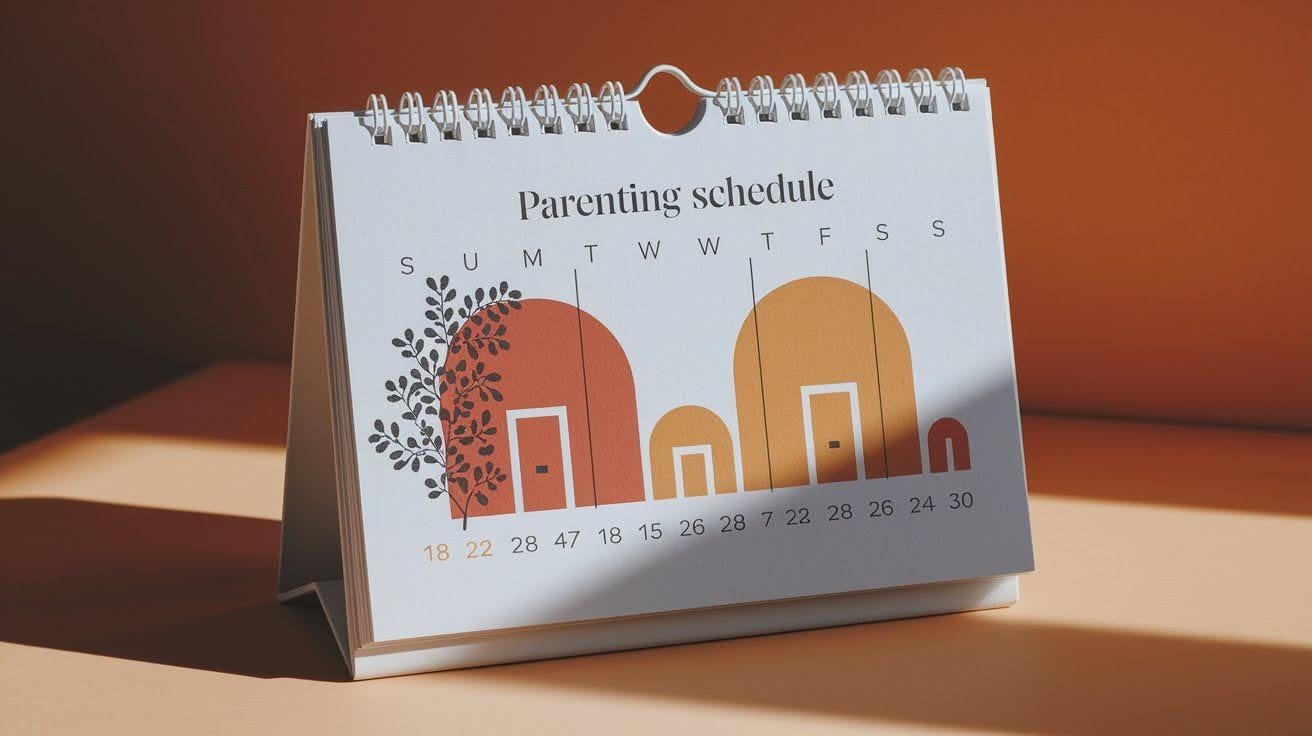Determining who will get the children when during a divorce is difficult enough without needing to become an expert in mathematics. Enter the 2-2-3 parenting schedule, a custody arrangement that is becoming increasingly popular among divorced parents seeking a more balanced approach than the traditional “every other weekend” pattern.
This is how it actually functions. After splitting the three-day weekends (Friday through Sunday), one parent gets Monday and Tuesday, and the other takes Wednesday and Thursday. The splendor?
Undoubtedly, it’s not flawless you’ll require a shared calendar that would make a business executive envious, and you can’t expect to make impromptu weekend plans without careful planning. However, for parents who value consistency and wish to make their children feel truly at home.
What is a 2-2-3 Custody Schedule?

A 2-2-3 custody schedule is a joint custody plan where a child spends two days with one parent, two days with the other, and then three days with the first parent. This cycle then repeats, giving both parents nearly equal time with the child over two weeks. It’s often used to provide young children with consistent routines and frequent contact with both parents.
This schedule is valued for its predictability and balance. Children know which parent they’ll be with on which days, reducing confusion and helping maintain daily routines. Both parents stay actively involved in school, activities, and everyday life.
However, the 2-2-3 plan requires good communication and cooperation between parents. Frequent transitions can be challenging, so it works best when parents live close to each other and coordinate logistics. Overall, it promotes fairness while keeping the child’s needs at the center.
Basic Definition and Structure
The 2-2-3 parenting schedule is a joint custody plan where a child spends two days with one parent, two days with the other, and then three days back with the first parent. This cycle repeats weekly, giving both parents nearly equal time with the child.
This schedule provides predictability and stability. Children know where they will be each day, which helps reduce stress and creates a secure routine. Parents can also plan work, school, and activities more easily.
It works especially well for younger children, who benefit from frequent contact with both parents. The schedule allows parents to stay involved in daily routines, schoolwork, and special moments, strengthening bonds in both homes.
How the 2-2-3 Schedule Works?
A typical week under the 2-2-3 schedule might look like this:
- Monday and Tuesday: Child stays with Parent A
- Wednesday and Thursday: Child stays with Parent B
- Friday, Saturday, and Sunday: Child returns to Parent A
This rotation gives each parent meaningful time with the child, allowing them to participate in everyday activities such as homework, sports, bedtime routines, and special outings. The frequent exchanges help children build strong relationships with both parents while maintaining a sense of normalcy and security.
Additional Considerations
While the 2-2-3 schedule is highly effective, it does require cooperation and flexibility. Frequent transitions mean parents need to communicate clearly about logistics, transportation, and any changes in routine. It works best when parents live relatively close to each other and maintain a cooperative relationship.
Another advantage is that this plan adapts well to special occasions. Holidays, birthdays, and school events can be scheduled in a way that balances fairness with the child’s needs, while still maintaining the regular rotation.
Overall, the 2-2-3 parenting schedule is a practical and child-centered approach that promotes fairness, routine, and strong bonds with both parents. It’s ideal for families seeking a balanced plan that keeps the child’s emotional well-being at the forefront.
Communication and Coordination Strategies
Good communication makes the 2-2-3 parenting schedule work better for everyone. Here are key ways to stay connected:
- Use shared calendar apps to track schedules and important dates
- Send daily updates between homes to keep routines consistent
- Create communication notebooks for younger children to track health, school, and feelings
- Set up regular check-ins between co-parents to solve problems quickly
- Prepare a consistent morning and bedtime routine across both homes
- Pack essentials (clothes, school supplies, comfort items) in advance for smooth transitions
- Keep a small “transition bag” for toys or comfort items that the child can carry between homes
- Agree on rules and expectations for homework, chores, and screen time to reduce confusion
- Encourage children to express feelings about the schedule and validate them
- Plan family activities to prevent scheduling conflicts
- Maintain flexibility for special events, holidays, or unforeseen circumstances
- Use technology (messaging apps, emails) to document agreements and reduce misunderstandings
How to Create Smooth Transitions?
Making transitions easier helps children feel more comfortable. These tips can help:
- Use shared calendar apps to track schedules and important dates
- Send daily updates between homes to keep routines consistent
- Create communication notebooks for younger children to track health, school, and feelings
- Set up regular check-ins between co-parents to solve problems quickly
- Prepare a consistent morning and bedtime routine across both homes
- Pack essentials (clothes, school supplies, comfort items) in advance for smooth transitions
- Keep a small “transition bag” for toys or comfort items that the child can carry between homes
- Agree on rules and expectations for homework, chores, and screen time to reduce confusion
- Encourage children to express feelings about the schedule and validate them
- Plan family activities to prevent scheduling conflicts
- Maintain flexibility for special events, holidays, or unforeseen circumstances
- Use technology (messaging apps, emails) to document agreements and reduce misunderstandings
- Plan morning transitions when possible. Kids handle changes better when rested
- Keep goodbyes short and positive. Long farewells often create more worry
- Keep the same comfort items (like blankets or stuffed animals) in both homes
How to Maintain Consistency Across Homes?
Keeping things similar in both homes helps children feel secure. Focus on these areas:
- Create the same daily routines from wake-up time to bedtime stories
- Use the same rules and discipline methods in both houses
- Keep similar meal times, homework schedules, and fun activities
- Encourage children to talk about their day at both homes to maintain consistency
- Coordinate on extracurricular activities and appointments to avoid conflicts
Where to Get Professional Support and Resources?
Sometimes families need extra help to make their schedule successful. Consider these options:
- Family therapists can help with transitions and emotional challenges
- Educational consultants ensure academic success across both homes
- Custody coordinators provide neutral guidance for high-conflict situations
- Use shared calendar apps to track schedules and important dates
- Send daily updates between homes to keep routines consistent
- Create communication notebooks for younger children to track health, school, and feelings
- Set up regular check-ins between co-parents to solve problems quickly
- Prepare a consistent morning and bedtime routine across both homes
- Pack essentials (clothes, school supplies, comfort items) in advance for smooth transitions
- Keep a small “transition bag” for toys or comfort items that the child can carry between homes
- Agree on rules and expectations for homework, chores, and screen time to reduce confusion
- Encourage children to express feelings about the schedule and validate them
- Plan family activities to prevent scheduling conflicts
- Maintain flexibility for special events, holidays, or unforeseen circumstances
- Use technology (messaging apps, emails) to document agreements and reduce misunderstandings
- Plan morning transitions when possible. Kids handle changes better when rested
- Keep goodbyes short and positive. Long farewells often create more worry
- Keep the same comfort items (like blankets or stuffed animals) in both homes
- Create the same daily routines from wake-up time to bedtime stories
- Use the same rules and discipline methods in both houses
- Keep similar meal times, homework schedules, and fun activities
- Encourage children to talk about their day at both homes to maintain consistency
- Coordinate on extracurricular activities and appointments to avoid conflicts
Practical Tips for Successful 2-2-3 Implementation
Implementing a 2-2-3 parenting schedule can be smooth and effective with the right approach. Clear communication, consistent routines:
- Talk openly: Share any changes, appointments, or special events with each other.
- Keep routines: tick to regular times for meals, homework, and bedtime.
- Use a shared calendar: Track schedules, pick-ups, and drop-offs together.
- Prepare for transitions: Give your child reminders and encourage a positive attitude.
- Stay flexible: Adjust when needed, but keep the main schedule the same.
Conclusion
The 2-2-3 parenting schedule gives families a structured and balanced way to share parenting duties. This plan ensures children keep strong, steady relationships with both parents through frequent rotation and equal time.
Success comes from clear communication, smooth transitions, and keeping things consistent in both homes. Using digital tools, maintaining similar routines, and getting professional help when needed make this schedule work better.
The 2-2-3 plan supports children’s well-being while letting both parents stay actively involved in parenting. With careful planning and teamwork, families can handle shared custody smoothly, creating a safe environment where children feel secure and loved in both homes.
Frequently Asked Questions
How does the 2-2-3 parenting schedule affect school-age children?
School-age children often adapt well to this schedule because it provides predictable routines. The frequent transitions help maintain close bonds with both parents while ensuring academic consistency.
What age groups work best with a 2-2-3 custody arrangement?
This schedule typically works best for children ages 3-12. Younger children may struggle with frequent transitions, while teenagers often prefer longer periods in one home.
Can the 2-2-3 schedule be modified for holidays and special events?
Yes, families can adjust the schedule for holidays, birthdays, and school breaks. Many parents alternate major holidays or split them to ensure equal celebration time.
How do parents handle transportation with frequent schedule changes?
Parents typically share transportation duties or meet at neutral locations. Some families use school as the transition point to reduce travel and make exchanges easier.
What happens if one parent wants to change the 2-2-3 schedule?
Schedule changes require agreement from both parents or court approval. Regular reviews every few months help identify needed adjustments before problems arise in the arrangement.







